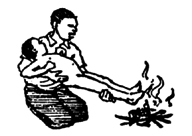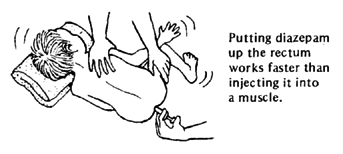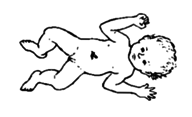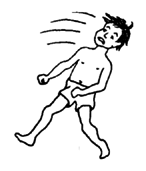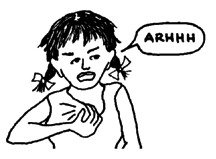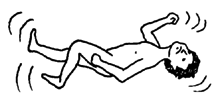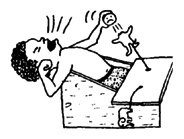CHAPTER 29
Fits
Epilepsy
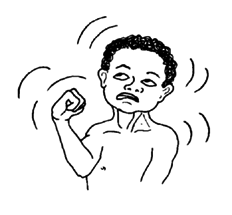
What are they? Fits (also called seizures or convulsions) are sudden, usually brief, periods of unconsciousness or changes in mental state, often with strange jerking movements.
One out of every 10 or 20 children has at least 1 fit by age 15. But only 1 in 50 of these children goes on to have chronic fits (repeated fits over a long period of time)-a condition known as epilepsy.
CAUSES OF CHRONIC FITS (EPILEPSY)
Fits come from damage to, or an abnormal condition of, the brain. Common causes include:
| Injury to the brain. This causes at least 1/3 of epilepsies. Injuries may be before birth, during birth, or at any time after. The same causes of brain damage that result in cerebral palsy can cause epilepsy (see Page 91). In fact, cerebral palsy and epilepsy often occur together. Meningitis is a common cause of this combination. In small children common causes of fits are high fever or severe dehydration (loss of liquids). In very ill persons, the cause may be meningitis, malaria of the brain, or poisoning (see Where There Is No Doctor, Page 178). Epilepsy that steadily gets worse, especially if other signs of brain damage begin to appear, may be a sign of a brain tumor (or of hydrocephalus in a baby-see Page 169). Fits caused by a tumor usually affect one side of the body more than the other. Rarely, fits may be caused by pork tapeworms that form cysts in the brain (see WTND, Page 143). | |
| Hereditary. There is a family history of fits in about 1/3 of persons with fits. | |
| Unknown causes. In about 1/3 of epilepsies, no family history or history of brain damage can be found. |
Fever fits. Children who have once had a fit with a high fever often will have fits again when they have a fever-especially if other persons in the family have had fits with fever. Be sure to check for infections of the ears and throat, as well as bacterial dysentery (diarrhea with blood and fever), and treat the cause.
Fits that come only with fever usually stop occurring by the time the child is 7 years old. Sometimes they may develop into 'non-fever-related epilepsy', especially if the child has signs of brain damage (see "Cerebral Palsy," Page 87 and 88).
| WARNING: Fits in a very ill child
may be a sign of meningitis - for which
immediate medical treatment is necessary to save his life. Learn
how to check for signs of meningitis (see Where
There Is No Doctor, Page 185).
The spasms of tetanus can be mistaken for fits. The jaw shuts tightly (lockjaw) and the body suddenly bends back. Learn to spot early signs of tetanus (see WTND, Page 182).
|
MORE ABOUT FITS (EPILEPSY)
Mental ability. Some children with epilepsy are intelligent. Others are mentally slow. Occasionally, fits that are very frequent and severe can injure the brain and cause or increase retardation. Treatment to control fits is important.
- Types of fits. Fits may appear very differently in different children. Some may have severe, 'big' or 'major' fits with strong, uncontrollable movements and loss of consciousness. Others may have smaller or 'minor' fits. These can be 'brief spells' with strange movements of some part of the body. They can be sudden unusual behavior such as lip-sucking or pulling at clothes. Or they can be brief 'absences' in which the child suddenly stops and stares-perhaps with blinking or fast movement of the eyelids.
- Some children will have both minor and 'big' fits or they may first have minor ones and later develop big ones.
Warning signs or 'aura'. Depending on the kind of fits, the child (and parents) may be able to sense when a fit is about to begin. Some children experience a 'warning' in which they may see flashes of light or colors. Or they may suddenly cry out. In one kind of fit, the 'warning' may be fear or imagined sights, sounds, smells, or tastes. In some kinds of fits there is no 'warning'. The child's body may suddenly jerk or be thrown violently. These children may need to continuously wear some kind of safety hat or other head protection.
- Timing of fits. Fits may happen weeks or months apart, or very often. Minor fits or 'absences' may come in groups-often in the early morning and late afternoon.
- Fits are usually short. Minor fits may last only a few
seconds. Big fits seldom last more than 10 or 15 minutes. Rarely,
however, a child may enter into a long 'epileptic state' which may
last hours. This is a medical emergency.
Some kinds of fits may appear at any age. Others begin in early childhood and usually disappear or change to other patterns as the child grows older.
Many persons have epilepsy all their life. However, some children stop having fits after a few months or years.
Usually there is no need to know the exact kind of fits a child has. However, some kinds of fits require different medicines. The chart on Page 240 and 241 describes the main types of fits, when they begin, and their treatment.
WHEN ARE SPECIAL MEDICAL STUDIES NEEDED?
In some poor countries, doctors sometimes prescribe medication for fits without properly checking for signs of causes that may need attention. However, more and more doctors regularly order expensive testing such as an 'EEG' (electroencephalogram). Even if these services are 'free', they are often only available in a distant city, which causes the family much time and expense. Such tests do not usually help much in deciding treatment-unless a brain tumor is suspected. And even if it is a tumor, the possibilities of surgery or successful treatment may be very small, and the costs are often much too high.
| Usually EEG's and other costly testing are not helpful. |
WHAT TO DO WHEN A CHILD HAS A FIT
| Learn to recognize any 'warning signs' that a fit is about to begin, such as sudden fear or a cry. Quickly protect the child by lying her down on a soft mat or other place where she cannot hurt herself. | |
| When a 'big' fit starts, do not try to move the child unless she is in a dangerous place. | |
| Protect the child as best you can against injury, but do not try to forcefully control her movements. Remove any sharp or hard objects near her. | |
| Put nothing in the child's mouth while she is having a fit - no food, drink, medicine, nor any object to prevent biting the tongue. | |
| Between spasms, gently turn the child's head to one side, so that spit drains out of her mouth and she does not breathe it into her lungs. | |
| After the fit is over, the child may be very sleepy and confused. Let her sleep. For headache, which is common after a fit, give acetaminophen (paracetamol) or aspirin. |
HEAD PROTECTION
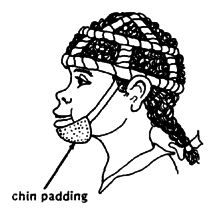
To protect the head of a child who falls hard when she has a fit, it may be wise for her to wear some kind of head protection most of the time.
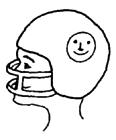 A child who often injures his face with fits may need a 'hard hat' helmet with a face mask. |
You can make a 'cage' of stiff wire and wrap it with strips of inner tube, soft cloth, or sponge rubber.

Or cut a piece of old car tire something like this.
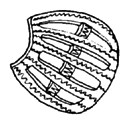
Or sew strips of cloth filled with padding.
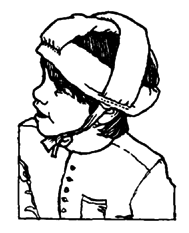
MEDICINES TO PREVENT FITS
There are no medicines that 'cure' epilepsy. However, there are medicines that can prevent the fits of most children-as long as they keep taking the medicine regularly. As long as a child has epilepsy-which may be for years or all his life-he must continue to take anti-fit medicines.
Sometimes preventing fits for a long time seems to help stop epilepsy permanently. For this reason, if the child has had many fits in the past, it is usually wise for him to keep taking anti-fit medicines regularly for at least one year after the last fit. Only then should you gradually lower and stop the medication to see if he still needs it.
| CAUTION: Great care is needed to select the medicines that help the individual child most, and which do her the least harm. Try to avoid giving so much medicine that she always seems sleepy, dizzy, slow-moving, or loses interest in things. A few fits may be better than too much medicine-which can poison the child. |
Choosing medicines
The best medicine (or medicines) for a child with epilepsy is one that is:
| effective (prevents the fits). | |
| safe (has few side effects). | |
| cheap (because it must be taken for years). | |
| easy to take (long-acting, few doses a day). | |
| easy to get. |
| WARNING: When a child is having a fit do
not put his feet into a fire. It will not 'frighten him
back to life' but will severely burn him.
|
Many different medicines are used for epilepsy. Some types of fits are controlled better by one medicine and some by another medicine, or by a combination of medicines. Some children's fits are easy to control. Others are very difficult. It may be necessary to try different medicines and combinations to find the most effective treatment. In a few children, no medicines will control the fits completely.
The best medicine to try first for almost all types of fits is usually phenobarbital. Often it is very effective, and is relatively safe, cheap, and easy to take. Its effects last for 24 hours, so that one dose a day is usually enough.
The next best medicine for 'big' fits is usually phenytoin. It is also fairly safe, cheap, and usually needs to be taken only once a day. (For some kinds of epilepsy, however, phenytoin may make fits worse.)
For most epilepsies, phenobarbital and phenytoin are often the best drugs. First try each alone, and if that does not work, try both together. Most other drugs are less likely to be effective, are often less safe, and are much more expensive.
Unfortunately, many doctors prescribe more expensive, less safe, and often less effective medicines before trying phenobarbital or phenytoin. Partly this is due to drug companies that falsely advertise their more expensive products. In some countries, phenobarbital is difficult to get-especially in pill form. The result is that many children's fits are poorly controlled, using drugs that cause severe side effects and that are very costly. Rehabilitation workers need to realize this and do what they can to help provide the safest, cheapest medicines that will effectively control each child's fits.
| CAUTION: To prevent choking, do not give medicines to a child while she is lying on her back, or if her head is pressed back. Always make sure her head is lifted forward. Never give medicines by mouth to a child while she is having a fit, or while she is asleep or unconscious. |
It is usually best to start with only one anti-fit medicine-usually phenobarbital, if available. Start with a low to medium dose, and after a week. if fits are not controlled and if there are no serious side effects, increase to a higher dose. After a few days, if the fits are still not controlled, add a second medication-usually phenytoin, for 'big fits'. Again, start with a low to medium dose and gradually increase as needed.
| CAUTION: When you stop or change a child's medicine, do so gradually. Sudden stopping or changing the medicine may make fits worse. Also, it may take several days for a new medicine to have its full effect. |

WARNING: All anti-fit medicines are poisonous if a child takes too much. Be careful to give the right dose and to keep medicines out of reach of children. |
INFORMATION ON DOSAGE AND PRECAUTIONS FOR ANTI-FIT MEDICINES
| Phenobarbital (phenobarbitone, Luminal
)
For all types of fits. Usually comes in: tablets of 15 mg. Dosage: Because tablet sizes differ, we give the dosage in milligrams (mg.). The usual dose is 3 to 6 mg. for each kg. of body weight every day (3 to 6 mg./kg./day) - usually given in 2 doses (morning and evening): Give 2 doses a day. In each dose give: children over 12 . . . . . . . 50 to 150 mg SIDE EFECTS AND COMPLICATIONS
CAUTION: If tablets of 100 mg. are used, be very sure the family understands that they must be cut into pieces. Show them first and then have them do it.
Giving a whole tablet instead of a small piece can poison the child. |
Phenytoin (diphenylhydantoin, Dilantin)
For all types of fits except brief fits that suddenly throw the child out of balance ('jolt fits') or 'minor fits' with staring, blinking, or fast movement of eyes. (Phenytoin may make these kinds of fits worse.)

Usually comes in: capsules of 30 mg.
capsules of 100 mg.
syrup with 125 mg. in each 5 ml. (1 teaspoon)
Dosage: using capsules of 100 mg. 5 to 10 mg./kg./day
Start with the following dose once a day:
children over 12 years . . . . 100 to 300 mg. (1 to 3
capsules)
children 7 to 12 years . . . . . . 100 mg. (1 capsule)
children 6 or under . . . . . . . 50 mg. (1/2 capsule)
After 2 weeks, if the fits are not completely prevented, the dose can be increased, but not to more than twice the amount.
If child has no fits during several weeks, try lowering the dose little by little until you find the lowest dose that prevents the fits.
SIDE EFFECTS AND COMPLICATIONS
| WARNING: Watch for dizziness, eye-jerking, seeing double, and severe sleepiness. Lower the dose if any of these occur. They are early signs of poisoning, which could cause permanent brain damage. |
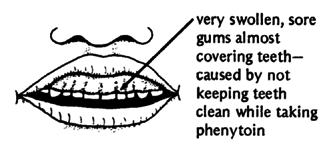
| Swelling and abnormal growth of the gums often occurs with long-time use. It can be partly prevented by good mouth care. Be sure the child brushes or cleans his teeth and gums well after eating. If he cannot do it by himself, help him, or better, teach him. If the gum problem is severe, consider changing medicines. (See Where There Is No Dentist, Page 109.) |
| Occasional side effects: increased body hair, rash, loss of appetite, vomiting. | |
| High dosage may cause liver damage. | |
| Bone growth problems sometimes occur-especially in retarded children. Extra vitamin D may help. |
| WARNING: Sudden stopping of phenytoin may cause the child to have a long-tasting fit. Therefore, when stopping or changing the medicine, lower the dosage gradually. |
| Carbamazepine (Tegretol)
Useful for almost all types of fits as a second choice, or in combination. Especially useful for 'psychomotor' fits (see Page 241). High cost is a disadvantage. (Unfortunately, many doctors prescribe it as first choice when cheaper drugs such as phenobarbital or phenytoin are likely to work as well or better.) Usually comes in : tablets of 200 mg. Dosage: 14 to 25 mg./kg./day divided into 2 to 4 doses. Start with 20 mg. eách day for each kilogram the child weighs. For example, a 30 kg. child 10 years old would start with 600 mg. a day, which she could take in 3 doses, each of 200 mg.-or one tablet 3 times a day. It is best to take it with meals. The dose of carbamazepine should be adjusted to the individual child. Depending on how well it controls the fits, it can be raised to 30 mg./kg./day (but no higher) or dropped to 10 mg./kg./ day. SIDE EFFECTS AND COMPLICATIONS
|
OTHER DRUGS SOMETIMES USED FOR EPILEPSY
| Primidone(Mysoline) For all fits. Start with low doses and gradually increase to 10 to 25 mg./kg./day in 2 to 4 divided doses. May cause sleepiness, dizziness, vomiting, or rash. | |
| Ethosuximide(Zarontin) First choice for 'minor fits' with blank staring, eye-fluttering, and perhaps strange motions - especially if the fits occur in groups in the morning and evening. Give 10 to 25 mg./ kg./day in 1 or 2 doses, with food to avoid stomach ache. Rarely causes liver damage. | |
| Valproic acid(Depakene) Used alone or in combination with other anti-fit drugs, for 'minor fits' with blank staring or 'absences', especially when the fits occur in groups. Start with 5 mg./kg./day and increase gradually to 30 mg./kg./day; never give more than 60 mg./kg,/day. Few side effects. Rarely causes liver damage. | |
| Mephenytoin(Mesantoin) Used like phenytoin but much more dangerous. May stop the body making red and white blood cells. Regular blood checks needed. 4 to 15 mg./kg./day divided into 2 doses. (We mention it here mainly to discourage its use.) | |
| Corticosteroids(or corticotropin) These are sometimes tried for 'baby spasms' and 'jolt fits' (see Page 240) that are not controlled by other medicines. But long-term use of these medicines always causes serious and possibly dangerous side effects (see Page 137). They should be used only with highly skilled medical advice when all other possible medicines have failed. | |
| Diazepam(Valium) Sometimes used for 'newborn fits' or 'baby spasms' (see Page 240), but other medicines should be tried first. May cause sleepiness or dizziness. Mildly habit forming. Give about 0.2 mg. for each kilogram of body weight per day, in divided doses. |
| CAUTION DURING PREGNANCY: Many of the anti-fit drugs, especially phenytoin, may increase the risk of birth when taken by pregnant women. Also, some of the drug goes into breast milk. Therefore, pregnant women should use these drugs only when fits are common or severe without them. Women taking fit medicine should not breast feed if they are able to feed their babies well without breast milk. Phenobarbital is probably the safest anti-fit medicine during pregnancy. |
TREATMENT FOR A LONG-LASTING FIT
When a fit has lasted more than 15 minutes:
if someone knows how, inject IV diazepam (Valium)
or phenobarbital into the vein.
| |||
| or put a 'suppository' of diazepam, paraldehyde, or
phenobarbital up the rectum (asshole). NOTE: These medicines do not work as fast or well when they are injected into a muscle. If you only have injectable or liquid medicine, put it up the rectum with a plastic syringe without a needle. Or grind up a pill of diazepam or phenobarbital, mix with water, and put it up the rectum.
|
If the fit does not stop in 15 minutes after giving the medicine, repeat the dose. Do not repeat more than once.
Types of epileptic fits
Note: This information is for rehabilitation workers and parents because many doctors and health workers do not treat fits correctly. With care, perhaps you can do better. However, correct diagnosis and treatment can be very difficult. If possible, get advice from a well-informed medical worker. Ask her help in using this chart. It is adapted from Current Pediatric Diagnosis and Treatment by Kempe, Silver, and O'Brien (Lange Medical Publishing), in which more complete information is provided.
| TYPE | AGE FITS BEGIN | APPEARANCE | TREATMENT |
| Newborn fits
|
birth to 2 weeks | Often not typical of later fits. May
show sudden limpness or stiffness; brief periods of
not breathing and turning blue; strange cry; or eyes
roll back; blinking or eye-jerking; sucking or chewing
movements; jerks or strange Movement of part or all of
body. WARNING: Make sure spasms are not from tetanus or meningitis (see Page 233). With cerebral palsy in the newborn, the baby is usually limp. Stiffness and/or uncontrolled movements usually appear months later, but the baby does not lose consciousness. |
Phenobarbital or phenytoin. Add
diazepam if not controlled. (Fits due to brain damage at birth are often very hard to control.) |
| Baby spasms (West's syndrome) |
3-18 months (sometimes up to 4 years)
|
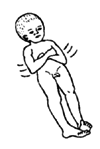
Sudden opening of arms and legs and then bending them - or repeat patterns of a strange movement. Spasms often repeated in groups when waking or failing to sleep, or when very tired, sick, or upset. Most children with these spasms are retarded. |
Corticosteroids may be tried-but are dangerous. Try to get help from an experienced doctor or health worker. Valproic acid or diazepam may help. |
| Fever fits (fits that only occur
when child has a fever)
|
6 months to 4 years | Usually 'big' fits (see
next page) that happen only when
child has a fever from another cause (sore throat,
ear infection, bad cold). May last up to 15 minutes
or longer. Often a history of fever fits in the
family. WARNING: Look for signs of meningitis. |
A child who has had fever fits on several occasions should be treated with phenobarbital continuously until age 4 or until one year after the last fit. Fits usually do not continue in later childhood. |
| Jolt or 'lightening bolt' fits
(Lennox-Gastaut syndrome)
|
any age but usually 4-7 years | Sudden violent spasms of some
muscles, without warning, may throw child to one
side, forward, or backward. Usually no loss of
consciousness, or only brief. Many children also have 'big' or generalized fits. May be a history of 'baby spasms' (see above) in earlier childhood. |
Try phenobarbital, with valproic
acid. If no improvement, consider trying
corticosteroids as in baby spasms, or other
medicines with medical advice.
Protect child's head with headgear and chin padding. |
Types of epileptic fits (continued)
| TYPE | AGE FITS BEGIN | APPEARANCE | TREATMENT |
| Blank spells or 'absences' (petit mal). (This type of fit alone is rare.) | 3-15 years
|
Child suddenly stops what she is doing and briefly has a strange, empty or 'blank' look. She usually does not fall, but does not seem to see or hear during the fit. These 'absences' usually happen in groups. She may make unconscious movements, or her eyes may move rapidly or blink. These fits can be brought on by breathing rapidly and deeply. (Use this as a test.) Often confused with 'psychomotor' fits, which are much more common. | Valproic acid or ethosuximide. Since many children also have 'big' fits, add phenobarbital if necessary (or try it first if you think the fits might be 'psychomotor'-see below). |
| 'Marching' firs (Focal fits) |
any age | Movement begins in one part of the
body. May spread in a certain pattern (Jacksonian
march) and become generalized.
Note : If fits that occur in one part of the body get worse and worse, or other signs of brain damage begin to appear, the cause might be a brain tumor. |
Phenobarbital or phenytoin (or both). It poor results, try carbamazepine or primidone. |
| Mind-and-body fits (psychomotor
fits)
|
any age | Starts with 'warning' signs: sense of fear, stomach trouble, odd smell or taste, 'hears' or 'sees' imaginary things. Fit may consist of an empty stare, strange movements of face, tongue or mouth, strange sounds, or odd movements such as picking at clothes. Unlike 'blank spells', these fits usually do not occur in groups but alone and they last longer. Most children with psychomotor fits later develop 'big' fits. | Try phenobarbital first - then phenytoin, or both together, then carbamazepine, or all 3 together. Valproic acid may also be useful. Or primidone instead of phenobarbital. Psychological counseling sometimes also helps. |
| Generalized or 'big' fits (grand
mal)
|
any age | Loss of consciousness-often after a vague warning feeling or cry. Uncontrolled twisting or violent movements. Eyes roll back. May have tongue biting, or loss of urine and bowel control. Followed by confusion and sleep. Often mixed with other types of fits. Often family history of fits. | Try phenobarbital first. Then phenytoin. Then carbamazepine-or combinations. Or combine primidone or methsuximide with one or more of the others. |
| Temper tantrum fits (not really
epilepsy)
|
under 7 years | Some children in 'fits of anger' stop breathing and turn blue. Lack of air may cause loss of consciousness briefly and even convulsions (body spasms, eyes rolling back). These brief fits, in which the child turns blue before losing consciousness, are not dangerous. | No medical treatment is needed. Use methods to help the child improve behavior (see Chapter 40). |
HELPING THE COMMUNITY UNDERSTAND EPILEPSY
Fits can be frightening to those who see someone having them. For this reason, epileptic children (and adults) sometimes have a hard lime gaining acceptance in the community.
Rehabilitation workers need to help everyone in the community realize that epilepsy is not the result of witchcraft or the work of evil spirits. It is not a sign of madness, is not the result of bad actions by the child or parents or ancestors, is not an infectious disease, and cannot be 'caught' or spread to other people.
It is important that epileptic children go to school and take part in day-to-day work, play, and adventures in family and village life. This is true even if fits are not completely under control. The schoolteachers and other children should learn about epilepsy and how to protect a child when she has a fit. If they learn more about epilepsy it will help them to be supportive rather than afraid or cruel. (See CHILD-to-child activities, Page 429.)
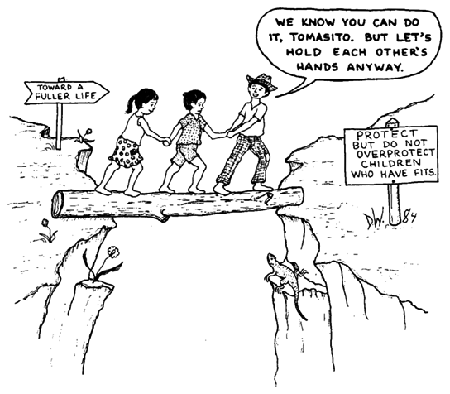
Although children with epilepsy should be encouraged to lead active, normal lives, certain precautions are needed-especially for children who have sudden fits without warning. Village children can learn to help in the safety of such a child-especially at times when danger is greatest.
PREVENTION of epilepsy
- Try to avoid causes of brain damage-during pregnancy, at birth, and in childhood. This is discussed under prevention of cerebral palsy, Page 107.
- Avoid marriage between close relatives, especially in families with a history of epilepsy.
- When children with epilepsy take their medicine regularly to prevent fits, sometimes the fits do not come back after the medicine is stopped. To make it more likely that fits will not come back, be sure that the child takes her anti-fit medicine for at least a year after her last fit. (Often, however, fits will still return when medicine is stopped. If this happens, the medicines should be taken for at least another year before you try stopping again.)



